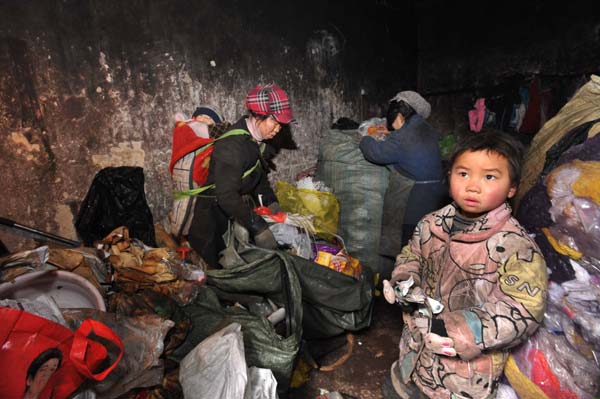Break cycle of poverty by putting children first
 |
|
Wu Run, a 6-year-old girl from a poor family, buries herself among garbage at a residential community in Guiyang, Guizhou province, on Feb 25. Wu Dongjun / for China Daily |
The very heart of the Sustainable Development Goals is to end poverty in all forms everywhere by 2030. To do this we must break the intergenerational cycle of poverty by putting children first. Not only because it's legally and morally the right thing to do, but also because it makes economic and social sense.
Children are more likely to be poor. Whether using the extreme poverty line or the Multidimensional Poverty Index, children are more likely to live in poverty than other groups. According to China's sixth national population census in 2010, the number of children living in poverty-stricken areas is estimated to be 70 million, accounting for about 25 percent of the child population nationwide. The mortality of children living in the poorest counties at each age is higher than the national average by 50 percent or more. About 5 percent of children in poverty-stricken areas do not complete compulsory education. Only 64 percent of children live with both parents.
Poverty goes beyond economic indicators. While inadequate household income is a significant driver of child poverty, poverty is about the set of deprivations that boys and girls experience across different aspects of their lives. These deprivations occur for children living within and outside designated income poor households, in rural areas and in cities, and include, hunger, lack of loving care, exposure to violence or abuse, social discrimination and exclusion, and poor access to basic services like education, water and sanitation.
Children suffer from the effects of poverty more than adults because even short periods spent in poverty in childhood can have irreversible effects on a child's physical, cognitive and social development. Poverty sets children on a life-long path of low educational achievement and reduced productivity, and undermines their physical and mental health. Children who grow up in poverty are more likely to become poor adults and have poor children, creating and sustaining intergenerational cycles of poverty.
While the largest costs are born by children themselves, society also pays a high price through loss of productivity, untapped potential and the costs of responding to chronic poverty.
We congratulate the government for its continued progress on poverty and for keeping poverty high on national and global agendas. The government has in place many plans to benefit children; poor children, children who have been left behind, orphans, and children with disabilities.
To ensure these plans reach every girl and boy with the services they need at the right time, they require good evidence. The child poverty analysis that the State Council Leading Group Office of Poverty Alleviation and Development and UNICEF conducted in Hubei province in 2015, examined the drivers of child poverty. Evidence from this analysis showed policymakers which children were at greatest risk, the kinds of deprivations that they experienced, and at which age interventions must be tailored to be most effective. This analysis was critical to develop effective and integrated child poverty programming in Hubei.
Decision-makers should commit to widespread use of the child poverty analysis, which is the basis for effective and efficient multi-sector programming. National, provincial and local plans and budgets for children need to be fully funded, implemented and evaluated. Lastly, if poverty is measured nationally, not only in rural areas, and a measure of child poverty is adopted to identify and track the children making the least progress, this would allow programs to steer investments first to the poorest children to help them catch up. It will also allow robust measurement toward achievement of all the Sustainable Development Goals, including Goal One, which includes a target to track multidimensional poverty for children as a specific group.
Making the choice to put children first in national development and poverty alleviation strategies is essential. With economic growth decelerating, policy choices will become harder. Investment in children ensures the best returns.
No strategy is more effective than to give every child a fair start in life. UNICEF is a proud partner in China and supports National efforts to realize child rights and end child poverty for good.
The author is UNICEF Representative in China.
























